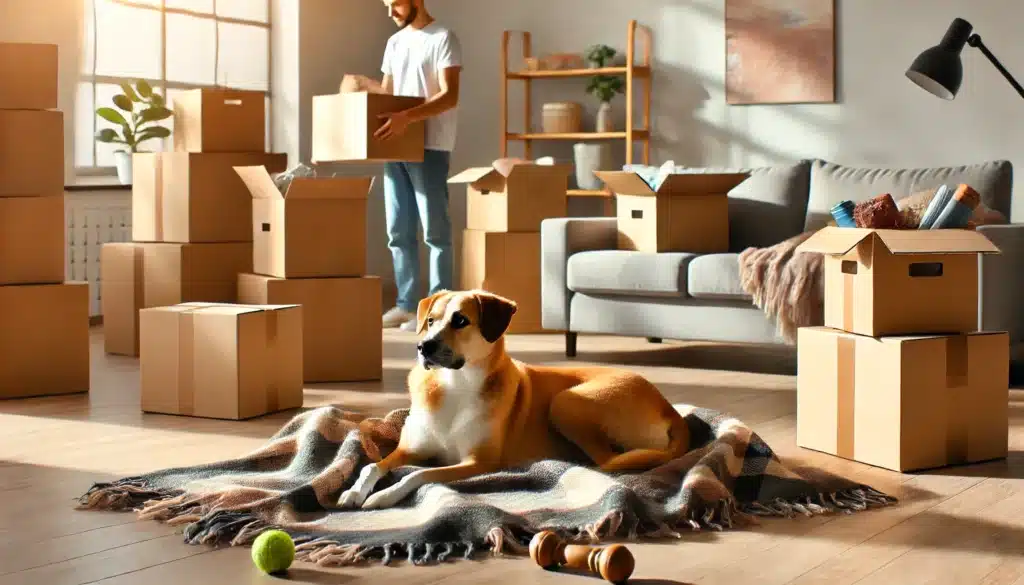Moving to a new home is exciting — but it’s also one of the most stressful experiences in life. Now imagine going through that transition without fully understanding what’s happening, where your belongings are going, or why everything smells different. For dogs, moving can be confusing, scary, and overwhelming.
But with a little preparation and empathy, you can help your furry friend adapt smoothly. In this guide, we’ll cover everything you need to know about reducing stress for your dog during a move, from packing day to settling into your new space.
Why Moving Is Hard for Dogs
Dogs are creatures of habit. They rely on familiar routines, smells, and surroundings to feel secure. A move disrupts all of that at once:
- New sights, sounds, and smells
- Strangers entering the home (movers, real estate agents)
- Sudden changes in furniture and layout
- More time alone during the transition
- Emotional shifts from their humans (dogs feel your stress, too)
Understanding this helps you approach the move with compassion and structure.
Before the Move: Preparation Is Everything
1. Keep the Routine Stable
As moving day approaches, try to keep your dog’s feeding, walking, and play schedule as consistent as possible. Familiar routines offer comfort in the midst of change.
2. Desensitize to Moving Supplies
Dogs can get anxious around boxes, tape, and commotion.
- Leave boxes out early so they become familiar
- Let your dog sniff and explore them
- Avoid loud or sudden packing sessions when your dog is nearby
- Use calm praise and treats to build positive associations
3. Create a “Safe Zone”
Designate one room in your current home as your dog’s quiet space while you pack.
- Keep their bed, toys, and water there
- Play calming music or white noise
- Ask family or friends to keep your dog occupied in that space when packing gets intense
4. Consider a Pet Sitter or Daycare for Moving Day
Moving day is noisy, chaotic, and full of open doors. If possible, arrange for your dog to:
- Stay with a trusted friend or family member
- Spend the day at a doggy daycare
- Be walked by a sitter
This prevents escape attempts, anxiety, and accidental injuries during the bustle.
During the Move: Managing the Transition
5. Travel Safely and Comfortably
When transporting your dog to the new house:
- Use a crate, carrier, or seatbelt harness
- Pack a bag with essentials (water, food, toys, leash, cleaning supplies)
- Give them a potty break before the trip
- Keep the environment calm and quiet (soft music, windows cracked if safe)
If the trip is long, plan rest stops for walks and hydration.
6. Bring Familiar Smells and Objects
In your new home, set up your dog’s space as soon as you arrive.
- Use their old bed, blanket, and toys
- Avoid washing items immediately — familiar scents = comfort
- Set up the same feeding station, if possible
Familiar objects in a new place help your dog feel grounded.
After the Move: Helping Your Dog Settle In
7. Reintroduce the Routine Right Away
Dogs crave consistency. Get back to regular feeding, walking, and potty schedules as soon as possible. This creates structure and reduces stress.
8. Supervise in the New Environment
Let your dog explore one room at a time before giving them access to the entire house.
- Watch for signs of anxiety (pacing, drooling, hiding)
- Block off unsafe areas
- Use gates or pens for gradual introductions
If you have a yard, supervise outdoor time until your dog is comfortable and the fence is secure.
9. Expect Some Regressions
Even well-trained dogs may:
- Have accidents indoors
- Bark more
- Seem restless or withdrawn
- Shadow you more closely
This is normal! Be patient, avoid punishment, and reinforce positive behavior gently. Most dogs adjust within a few weeks.
Bonus Tips for Apartment Moves
- Introduce your dog to elevators, stairs, and hallways gradually
- Practice quiet behavior in shared spaces
- Use treats and praise to associate new sounds and people with positivity
- Confirm pet rules and regulations with the new building in advance
When Moving with Multiple Dogs
- Move them together if they’re bonded
- Introduce the new home gradually, one at a time, if they have different personalities
- Maintain individual routines and attention for each dog
- Watch for resource guarding or stress-related tension between them
When to Seek Help
If your dog continues to show signs of distress for more than a few weeks — or their behavior becomes unmanageable — consider working with:
- A professional dog trainer or behaviorist
- Your veterinarian, to rule out health-related anxiety
- A vet specializing in behavior for more severe cases
Early support can prevent long-term stress or behavioral problems.
Final Thoughts: Home Is Where You Make It — Together
Moving can feel chaotic and overwhelming — for you and your dog. But with patience, planning, and a little extra love, your new space can quickly become a place of comfort, safety, and routine.
Take it slow, maintain the familiar, and be there to guide your dog through the transition. Because no matter where you go, what truly makes a place home is the bond you share.







